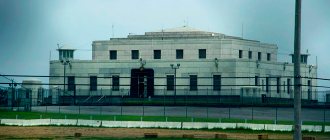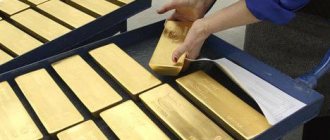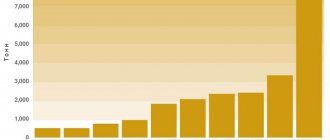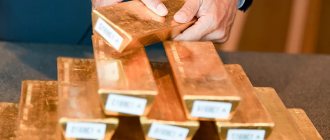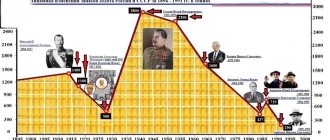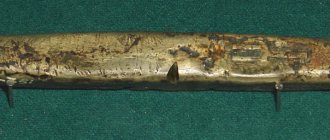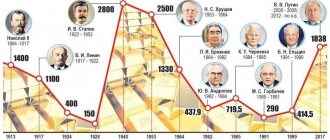The gold and foreign exchange reserves of the United States of America rank first in the world, giving the dollar a priority position among other national currencies. However, it is precisely around the American gold reserve that heated debates constantly take place, the participants of which often claim that this reserve simply does not exist. Indeed, an audit of the main storage facility, the military fortress Fort Knox, has not been carried out for more than 10 years. At the same time, America has been actively driving down gold prices on the world market all these years.
But guesses remain guesses, and official statistics claim that more than 8 thousand tons of pure 999 gold have been accumulated in this country today. And this fact supports the status of the American dollar not only as the main world currency, but also as a universal money in which the value of gold itself is measured.
Gold in the USA - a brilliant story of triumphs, bankruptcies and fraud
The first mention of the official purchase and sale of gold currency dates back to 1792. Then for one ounce in the young North American states they gave 19.35 dollars. Oddly enough, the main incentive for the first serious gold accumulations in America was the Great Depression. In the midst of a powerful economic crisis, the government called on the population to hand over all reserves of the precious metal at a price of 20.6 dollars per 1 ounce. After American citizens followed the advice of the authorities, the price of the “yellow devil” soared to $35 per ounce. And the state received at its disposal the basis of the future gold reserves.
The heyday of precious metal accumulation in this country began during the Second World War. It was during the period from 1941 to 1945 that America increased its gold and foreign exchange reserves to 20 thousand tons! The sale of weapons and the seizure of gold from losing countries became the main source of the future economic power of the modern United States. That is why this state has become a leading player in the global financial and stock market. And the American dollar was recognized as the dominant instrument for international payments.
Currently, many states (about 60 developed countries) store physical gold bars in America. The gold reserves of countries in the United States are kept top secret, however, there are persistent rumors that at least 20% of Russia's gold and foreign exchange reserves are stored overseas in the safes of our eternal rival.
In fact, the United States has lost its reputation as a reliable international gold repository in recent years. Moreover, when in 2009 China requested part of the bars (5,600 bars of 400 ounces), the Americans sent an obvious fake to the Celestial Empire. The bars tested by experts turned out to be smelted from tungsten and coated with gold amalgam. It is clear that a big international scandal broke out over this. And since then, many experts are confident that the US gold reserve has long been a fiction. And America, in case of extreme need, simply spends the precious metal entrusted to it for safekeeping by other states.
What about Russia?
Russian gold, as a rule, is not purchased on international exchanges. In the vast majority of cases, Russian gold mining companies become sellers of the precious metal. Therefore, for security reasons, it is stored on the territory of the country.
Russia is the fifth largest owner of the precious metal. In national storage facilities its quantity is more than 2300 tons. Only the USA (8133 tons), Germany (3364 tons), Italy (2450 tons) and France (2430 tons) have more.
Where is the main US gold depository located?
About half of the US gold reserves (4,110 tons) are stored at the military base at Fort Knox, Kentucky. This powerful fortified structure is capable of withstanding attacks by an entire army and a nuclear explosion. Therefore, attackers never attempted to storm the most reliable storage facility in the world.
The second part of the strategic foreign exchange reserves (about 7,000 tons) is stored at the Federal Reserve Bank of New York. Here, under the protection of ultra-reliable safes, gold bars from different countries that have entrusted their national wealth to America are stored. This is where the daring criminals broke in in the legendary action movie Die Hard 3.
The ultra-modern bunker is located 24 meters underground and 15 meters below sea level. However, experts say storing so much wealth in climatically and geophysically fragile Manhattan is hardly justified. An interesting fact is that the current storage facility is an open tourist site, which is visited annually by thousands of curious travelers from different countries.
Relationship between the US gold reserve and the dollar
Adopted at the end of January 1934, the Gold Reserve Act stabilized the dollar after the Great Depression, becoming a new starting point in the rapid evolution of this currency. From then on, the President of the United States guaranteed the stable price of gold at $35 per ounce and the gold backing of American paper money. This meant that any owner of dollar bills could exchange them for the corresponding amount of yellow metal at the mentioned fixed rate.
In July 1944, the peg of the dollar to gold was strengthened by the famous Bretton Woods Act, which turned the American currency into a universal means of mutual settlements between forty-four developed countries. After that, for 20 years, all major currencies, including the British pound, fell in value against the US dollar.
The most significant incident with dollars and gold occurred in 1965, when French President Charles de Gaulle collected paper dollars throughout the country and took them by ship to his ally to exchange for gold. At that time, the gold standard was still in effect, and American currency could legally be exchanged for precious metal at any time. The then US President Lyndon Johnson had to exchange one and a half billion “unnecessary pieces of paper” at 35 dollars per ounce. Since then, France has confidently occupied a respectable fourth place in the gold and foreign exchange ranking (about 2450 tons in 2019).
Around the same time, Germany also tried to return its bullion, which had been deposited at Fort Knox. But after secret negotiations between the governments of the two countries, the German authorities publicly stated that they fully trust the United States and are ready to continue to keep about half of their reserves in this country.
On August 15, 1971, US leader Richard Nixon issues a decision ending the gold standard for the US dollar. This decree ended the history of the “gold dollar”, sending American money into free floating. Since then, the dollar is no longer backed by the country’s gold reserves, no matter how much these reserves actually amount to.
New in blogs
Such news has long ceased to be a sensation. Recently, an Australian gold dealer went on record saying that his supplier had provided photographic evidence of a one-kilogram gold bar that was, in fact, counterfeit. Interestingly, a hand-held X-ray fluorescence scanner confirmed that the object being examined was an ingot consisting of 99.98% pure gold. However, when it was sawed into two parts, it turned out that there was only a thin shell of the noble metal. And the entire ingot consists of much cheaper (compared to gold) and very base tungsten.
And one more important detail: this jewelry “miracle” turned out to come from the vaults of the US Federal Reserve Fund. This is not the first time such a scandal has happened with American pseudo-gold.
So, a couple of years ago - the Canadian newspaper Press Core told the world about this - the US Treasury Department sent 5,600 gold bars of 400 ounces each to China, as part of repaying the national debt. The Chinese turned out to be meticulous people. They decided, just in case, to check the weight and purity of the ingots. I think you can already guess what they found in the end. All the ingots turned out to be tungsten with a thin coating of gold.
Before traveling to the Celestial Empire, they lay for several years - like gold - in the safes of a storage facility in Fort Knox (Kentucky). The Chinese government did not make a secret of what happened, publicly declaring that the United States was involved in gold fraud. After analyzing the registration numbers on the bars, the Chinese concluded that the counterfeit was manufactured during Clinton's presidency.
The United States, of course, tried to do everything possible to hush up the scandal. But the cards were confused by the American scientist and expert on the precious metals market, Rob Kirby, who posted a report on the Internet that the number of ingots “stuffed” with tungsten was approximately 60 tons. Fake gold bars were exchanged for real ones from the Fort Knox vault, which then disappeared in an unknown direction.
The criminal operation was carried out by the Clinton administration, which, tired of fighting for the dying dollar, decided to commit ordinary fraud, albeit on a very large scale. According to Crisby, who is ready to document it, most of the pseudo-gold bars remained in storage in America, and the rest was sold on the international market.
In general, the United States carried out a typical operation for itself. They made bullshit and sold it like the real thing. At the same time, America never tires of talking about how rich it is and how much gold is stored in its bins. Thus, according to official statistics, the reserves of the “yellow devil” held by the United States are more than 2 times greater than the amount of gold held by Germany, which ranks second in the list of countries holding the precious metal.
But how much do official statistics reflect the true state of affairs? How much gold does America really have? And what percentage of it - in light of the above events - is real?
It turned out that answering these questions is almost impossible. Reliable documentary evidence about the state of the United States gold reserves cannot be found, and the last audit of US gold and foreign currency storage facilities was carried out during the reign of Tsar Pea. True, a bill was recently prepared that provides for the inspection of more than 5 thousand tons of bullion stored in Fort Knox safes. The audit will also affect gold reserves held at various institutions in West Point, Denver, and the Federal Reserve Bank in New York.
Time will tell whether the American congressmen will approve this bill, and whether the audit will tell the truth about what is stored in the safes - gold or tungsten bars. It should be borne in mind that the US Federal Reserve Bank, as it accidentally turned out during a trial 30 years ago, is... a private organization. Imagine: America’s gold and currency reserves are controlled by a few cunning “comrades”! Yes, they can do anything for the sake of profit, and not just steal gold bars, replacing them with tungsten ones.
However, something else is interesting now: how far can Americans go in an attempt to deceive everyone with their inflated wealth, which allows them to shout about the greatness of the dollar? But it is precisely on this currency that today’s global financial system rests – with all its might.
Let us recall that in the 30s of the last century, due to the collapse of the gold standard, the unified international monetary system broke up into a number of currency blocs, the main of which were the sterling, dollar and French franc bloc. However, the growing integration of economic relations between countries required the emergence of a single currency of account.
And then the Americans came to the rescue. At the Bretton Woods Conference, held in 1944, two fateful decisions were made. The first of them is that the dollar was recognized as the main international reserve and settlement currency. Second, the United States guaranteed the treasuries and central banks of other countries to exchange paper “Uncle Sam” for gold. By the way, at the Bretton Woods Conference it was decided to create the International Monetary Fund, which today acts as an economic killer for those countries that recklessly decide to take advantage of its financial assistance.
The global financial system did not last long in this form. In 1971, the US government declared, in essence, a technical default, refusing to exchange dollars for gold. For one simple reason. Gold has run out: from 1949 to 1970, reserves of the yellow metal in the United States decreased by more than 2 times. The last handful of soil was thrown into the grave of the Bretton Woods system by French President General de Gaulle, who not only announced his desire to exchange 1.5 billion US dollars, but also brought with him 750 million “greenbacks” during one of his official visits. The Americans had nowhere to go, the exchange took place. Germany soon followed the example of France.
This could mark the end of the history of the power of the dollar as a global currency of account. But financial tycoons of all stripes, international swindlers and speculators making capital through currency usury, did not want to part with the “green”.
Therefore, almost 7 years after the collapse of the Bretton Woods agreements, on April 1, 1978, a new international monetary system began to function, based on the principles of the Jamaica Agreement, adopted in the capital of this state, Kingston, in January 1976.
This system is still in effect today. It has a number of features, but attention should be paid to the main thing: the dollar has remained the main international settlement and reserve currency, but its value is not backed by gold. In other words, for more than 40 years, “green” has been an empty piece of paper, the exchange rate of which relative to other currencies is artificially maintained at a certain level.
Financial scientists have even described a paradox (the so-called Triffin dilemma). On the one hand, the issue of currency must correspond to the gold reserves of the issuing country. Excessive issuance not backed by gold undermines confidence in money. However, a currency that is recognized as key in international payments must be issued in such volumes as to meet the needs of the entire world economy. Therefore, it “has to” be printed, without paying attention to the volume of gold reserves of the issuing country.
This is how it turned out that the Americans filled the world with a dollar that had neither stake nor yard behind its soul. Now answer, as they say in Odessa: why do we need this? Americans love their dollar, so let them play with it. What do we have to do with it? After all, if the dollar exchange rate collapses - and this can happen at any moment, because nothing is holding it back - then it will cause harm to the economy, it’s scary to even imagine.
But the Americans do not want to part with the “title” of holders of the world’s key currency. That's why they started a war with Iraq, which wanted to trade oil not in dollars. Today, the Americans are destroying Libya, which has hinted at switching to payments for “black” gold in a currency backed by real gold. They do their best to interfere with countries that have agreed to pay each other in national currencies. And the United States is also thinking about which other countries with gold reserves it should launch military operations against in order to replenish the Fort Knox safes with real precious metal.
Oleg Nabatov, specially for VREMEYA.UA
US gold reserves today
According to official statistics, the US gold reserve for 2021 was 8,135 tons. This enormous figure still makes an impression on the world economy. For example, Germany, which ranks second, has only 3,370 tons. Such an impressive gap, as mentioned above, was achieved during the Second World War, when America made a good profit at the expense of the USSR and the losing countries.
Currently, a serious economic conflict is brewing between the United States and China. And China, as the main holder of American government debt, following the example of Charles de Gaulle, can present these papers at any time to receive debt. If US gold reserves really are as large as official figures, then America will have little difficulty paying off all its bonds. Otherwise, the country must declare a default, which will lead to a temporary collapse of the entire world economy. That is why Russia has been the largest buyer of gold bullion for the last seven years, increasing its reserves in the precious metal at an unprecedented pace. And in the event of a dollar collapse, our country is ready to switch to the international gold standard.
General mistrust
Today, many rulers of countries express a desire to return gold from the US Federal Reserve. Their fears stem from doubts that America could have spent their property long ago. But the US government itself claims the opposite, and insists that the gold reserves of other countries are completely safe and inviolable.
Economists around the world agree that the return of their gold to countries will have a positive impact on the global economic situation. In addition, it has long been unsurprising that some countries store their precious reserve reserves in the United States, because history shows that in most cases the empire keeps the gold of its colonies at home.
